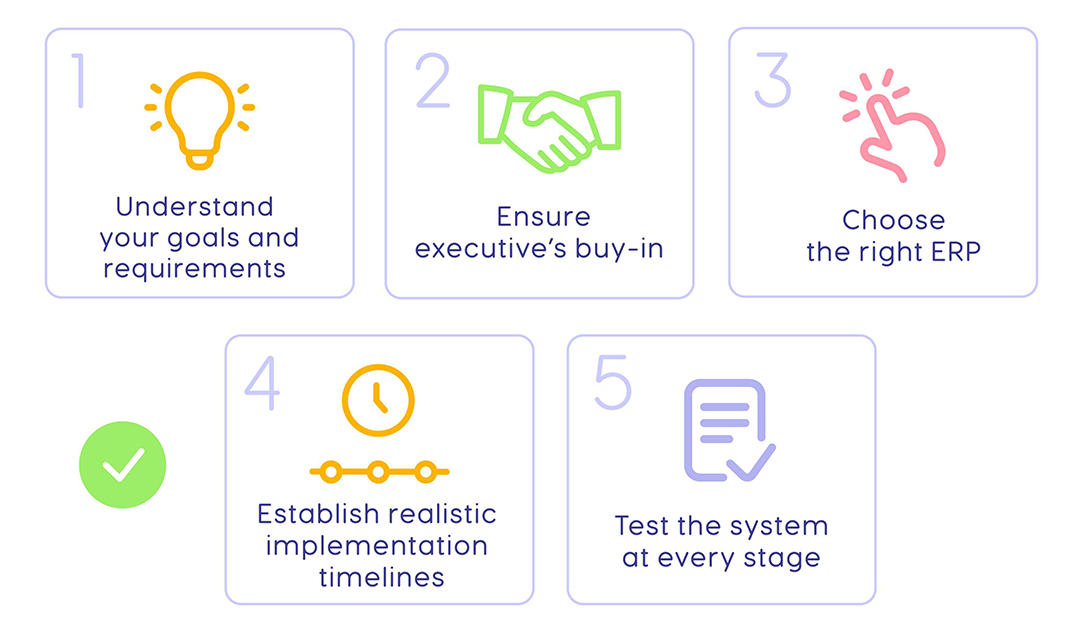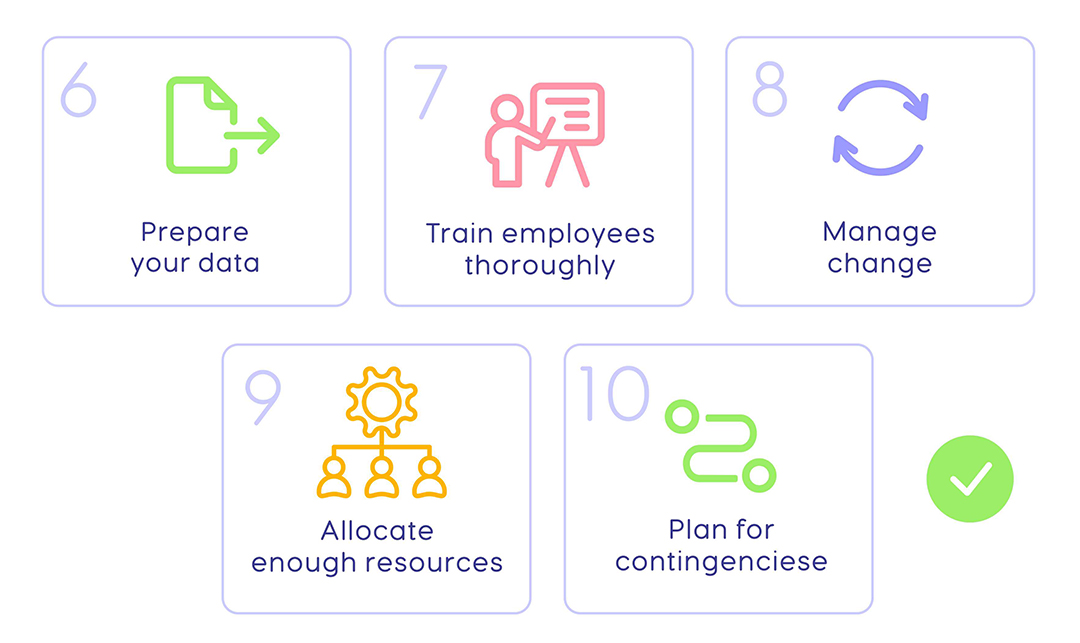
Enterprise resource planning systems (ERP) are important drivers of successful digital transformation and organizational success. They help companies unify their business processes, increase their efficiency, and improve decision making. But at the same time, ERP implementation can become a serious challenge. Adopting ERP is costly and time-consuming, so no one will be happy if it doesn’t deliver the expected results and becomes a waste of time and money. In this context, it becomes critical for business organizations to know the main reasons why these initiatives may fail.
Read the article to understand the main causes of ERP implementation failures and learn how to prevent this disaster.
What Are the Most Common Reasons for ERP Implementation Failures?
ERP implementation failure is a situation where the adoption of an enterprise resource planning platform doesn’t deliver the expected outcomes and benefits. In particular, this may refer to missed deadlines, budget overruns, inability to work with the new system, its ineffectiveness, etc. But why does it happen? Let’s take a closer look at the reasons.
Poor planning and preparation
Proper planning and preparation are the backbones of any successful process, and ERP implementation is no exception. ERP projects are large and embrace diverse areas of business, which means that there are lots of things to take into account at the planning stage. Poor planning of ERP implementation may result in unclear objectives of this endeavour, ineffective resource allocation, or poor risk management strategy. In a worst-case scenario, this leads to ERP system implementation failures.
Unrealistic timelines
ERP implementation can provide organizations with numerous benefits. However, achieving this value may take some time, especially for large enterprises. ERP implementation can be accompanied by some challenges that can be overlooked when an organization is rushing through the implementation process. In addition, this creates pressure for employees and reduces the effectiveness of important processes like employee training or change management.
Insufficient testing of the software
Software testing is a critical process of the ERP implementation project. Unfortunately, this stage is often underestimated, which can lead to unpleasant surprises. Without proper testing phases, organizations may fail to detect functional issues, face integration problems, data errors, or poor user experience. It may seem that skipping thorough testing will save time, but insufficient testing puts the entire ERP project at risk.
Poor data preparation
This aspect of ERP implementation can be easily overrated when companies focus on the tool selection, employee training, or other aspects. But at the same time, poor data preparation can become a significant hurdle for ERP implementation success. Garbage in, garbage out – this rule is also relevant for successful ERP functionality. Inaccurate data can cause operational disruption, poor decision-making, delays, or other inefficiencies that will put ERP implementation at stake.
Improper user training
Even the best ERP system in the world won’t deliver the expected value if its users don’t know how to use this software correctly. When employees are poorly prepared and not provided with sufficient technical support, it may lead to errors, decreased productivity, and their resistance to change, which will make the success of ERP implementation questionable. So, skipping thorough employee training will not delay the positive changes, but can be a serious issue causing ERP adoption failure.
Disengagement of employees
Disengaged employees pose a hidden risk to the success of ERP implementation. Why hidden? Because disengagement can be often silent and not implicit. Disengaged and unmotivated people can miss important ERP implementation activities like testing or training, use the system incorrectly, be resistant to changes, work with delays and make mistakes. Therefore, disengaged employees become not just silent participants of ERP implementation, but those who can undermine ERP implementation success.
A lack of resources
It’s no secret that every project requires enough resources to be completed successfully. Similarly, ERP implementation requires significant investments of resources – time, employees, and money. When a company has understaffed project teams, insufficient budget, limited time, and inadequate technical infrastructure, it will be difficult to implement the ERP system successfully.
Poor change management
The implementation of an enterprise resource planning system isn’t just software adoption, it’s a transformation on the organizational level. It changes how people will work, communicate, and make decisions every day. There’s a high probability that without purposeful and thorough change management, employees will demonstrate resistance to these changes. Resistance hampers mastering the new ways of working, which in turn jeopardizes the success of ERP implementation.
No management support and involvement
As we noted earlier, ERP implementation is an organizational transformation. It requires proper coordination and commitment of all participants of the process, including a company’s leadership. Without executives’ support, ERP implementation project may lack clear objectives and authority. In addition, this may lead to poor resource allocation, decision-making, and failure to implement organizational change. Obviously, this can contribute to ERP implementation failure.
Neglecting industry standards and ERP implementation best practices
This factor can become a costly oversight in ERP implementation. Ignoring these aspects makes organizations reinvent the wheel, which wastes time and effort, causes redundant customization, complicates training, and leads to delays and inefficiencies.
Read more: Top 7 Reasons for Project Failure in a Multi-Project Environment
It’s better to learn from others’ mistakes, so let’s consider some costly and impressive examples of the biggest ERP implementation failures occurring at famous companies.
Famous ERP Implementation Failures: Case Studies
Nike
In 2000, Nike adopted an ERP system in an attempt to automate the supply chain management in order to forecast the demand for products more accurately. They invested $400 million in this project, but, unfortunately, it failed. The reason? Insufficient testing of the system, which led to numerous software bugs, the need to engage more resources, and wrong forecasts. As a result, the supply chain collapsed, and the company lost its revenue. [1]
Waste Management, Inc.
As ERP implementation failure example that we can mention here, let’s consider the case of Waste Management Inc. They tried to adopt SAP ERP, but their mistake was that they ignored the tool’s standard processes and decided to customize them. This resulted in project failure. [2]
Hewlett Packard
In 2004, HP decided to replace their legacy systems with the innovative ERP solution. But instead of process improvements, they got numerous issues. As a result of poor change management and data silos, their ERP implementation project failed, causing reduced sales and a huge loss in revenue. [1]
Hershey
Hershey company experienced failure of the ERP implementation project due to reducing its timeline from 48 to 30 months. They didn’t have enough time to train employees, and the launch of the software became a failure. As a result, the company had 19% decrease in profit and 12% decrease in sales. [1]
Target Canada
The ERP implementation experience for this company was hard. The implementation timeline was tight, while the employees responsible for entering data into the new system were undertrained. The result? 70% of the new data was entered with errors. Another mistake of the company was that they tried to implement the new system in all its new stores, which was ineffective compared to taking a phased approach.
Even the large industry players can make mistakes. Recent ERP implementation failures serve as lessons to other companies, demonstrating that understanding the reasons for potential failures of ERP implementation is important. But it’s no less essential to know what steps can prevent these projects from failure. Let’s consider them in the next section.
How to Prevent ERP System Implementation Failures: 10 Actionable ERP Implementation Tips
Tip 1. Understand your goals and requirements.
Like with any process improvement endeavor, before implementing a complex and costly ERP system, you and a company’s leadership should understand “the why” – why is it necessary to invest in the new system? What problems is it going to solve in your organization? What processes should be improved? So, start from determining clear goals, developing KPIs for tracking progress, and getting leadership’s approval of the initiative.
Tip 2. Ensure executives’ buy-in.
As long as ERP implementation is not just a project, but rather an organizational transformation, getting support and active involvement of the senior leadership is critically important. This is one of the determining factors of the implementation strategy success – this will impact finding, resource allocation, and change management.
To ensure leadership support of ERP implementation, you should connect this initiative to a company’s business objectives, create a compelling business case, choose the right sponsor, ensure regular communication and provide them with regular updates.
Tip 3. Choose the right ERP.
Relying on your organization’s needs is a critical factor when selecting the appropriate ERP system. You should check the solution’s alignment with the industry, the size of your organization, and its growth potential. To make the choice easier, you can perform a thorough analysis of your organization’s needs and what ERP vendors claim to address them. You can also attend demos and/or run pilot implementations to see the systems in action. Don’t forget to engage users in this process and discuss your potential choice with them.
Read more: How to Choose the Right Project Management Software: Selection Guide
Tips 4. Establish realistic implementation timelines.
As we’ve noted earlier, too tight timelines become the cause of ERP failure, which was even illustrated by real-life examples. So, you should factor in time for testing the system, change management, and employee training. There’s one more essential factor to add to time estimates – contingency buffers so that unexpected external factors won’t ruin the implementation project. Also, divide the implementation process into several phases and set realistic deadlines without the pressure to implement it as soon as possible.
Tip 5. Test the system at every stage.
Improper testing of the ERP system can result in bugs, data errors, or other problems after the software launch. In contrast, appropriate testing can effectively check the functionality of the system, its performance, user experience, and other essential parameters. To make the testing process more effective, you can test different scenarios and see the new system’s response to them.
Tips 6. Prepare your data.
Data migration is one of the core components of ERP implementation process. Poor data quality causes mistakes and inefficiencies, which can significantly hamper the success of ERP implementation. To avoid these issues, you should determine what data is required for the new ERP, standardize data formats and values, and make sure that you migrate only clean and validated data sets.
Tip 7. Train employees thoroughly.
As we’ve seen in the examples, without proper training, users can use the ERP system incorrectly or resist the change, which can result in ERP implementation problems. Training increases users’ confidence, reduces the possibility of mistakes, and facilitates achieving the desired implementation outcomes. This is why, it’s recommended to develop a robust training program, focus on training those who will use the new system most, incorporate real-life cases and practice into the training. Finally, you should allot enough time for the training and make sure that it was effective.
Tip 8. Manage change.
Resisting changes is natural, this is how our brain works. However, overlooking the importance of change management, which is critical for ERP implementation success, can become a costly mistake. The primary goals of change management are to reduce employees’ resistance and ensure their engagement and commitment to the ERP implementation initiative. To manage change effectively, you should communicate with ERP users regularly: explain what will change exactly, why it is important for the entire organization in general and their everyday work in particular. Proper training is another pillar for overcoming resistance to change.
Tip 9. Allocate enough resources.
Implementing an ERP system requires resources – time, budget, people, and infrastructure. The actions below will help you allocate the right resources to this initiative:
- Create a dedicated ERP implementation team;
- Allocate a realistic budget suitable for the full project lifecycle;
- Make sure that core team members have enough time to work on the project;
- Take care of technical infrastructure preparedness;
- Provide employees with required resources: training materials, documentation, SOPs, support channels, etc.
Tip 10. Plan for contingencies.
Preparing for contingencies and uncertainties is critical for the success of any project. Especially for large, complex, and unpredictable like ERP implementation, where lots of things can go wrong. Planning for contingencies, you can reduce the risks of ERP adoption failures, prevent budget overruns, and minimize timeline disruption. Also, this increases employees’ readiness for challenges, ensures proper responses to unexepcted situations, and increases chances for successful ERP implementation.
Applying the above-mentioned recommendations allows companies to reduce the risk of ERP project failure and set the right direction for successful implementation journey.
Conclusions
ERP implementation is a very transformative and at the same time challenging initiative for business organizations. On the one hand, it can dramatically improve processes and facilitate successful business transformation. On the other hand, poor execution of an ERP project can cause difficulties and significant financial losses. This is why, it’s critically important to know and take into account the main reasons leading to the failure of ERP implementation projects.
To prevent ERP implementation failures, you can utilize a smart software solution like Epicflow. It’s a resource and portfolio management tool that optimizes resource allocation, decision making, supports forecasting and change management. Finally, it facilitates smooth execution of an ERP implementation project, more predictable delivery as well as reduces bottlenecks and risks. Contact our experts to learn more about the variety of Epicflow’s functionality that can support your organization in executing projects.
References
- ERP Failure Case Studies. Retrieved from: https://www.scribd.com/document/541836288/Erp-Failure-Case-Studies
- Waste Management, Inc. Wikipedia. Retrieved from: https://en.wikipedia.org/wiki/Waste_Management%2C_Inc.
Frequently Asked Questions
What are the failures of ERP implementation?
ERP implementation fails when the system cannot meet a company’s business goals, causes disruptions in its operations, or when the implementation timeline and budget are exceeded.
Which factor contributes to the failure of ERP implementation?
There are numerous factors contributing to ERP implementation failure. They include poor planning and preparation, a lack of management support, poor change management, insufficient user training, poor data preparation, and improper testing.
How to overcome the failure of ERP software?
To overcome the failure of ERP software, you should assess the situation thoroughly, stabilize essential business processes, ensure stakeholder involvement, structure the data, replan the implementation project, and work on change management.
Why are ERP implementations so hard?
The most challenging factor about ERP implementation is that it combines the use of technology with organizational change. Also, they are costly, risky, depend on data, and take long time to execute.










